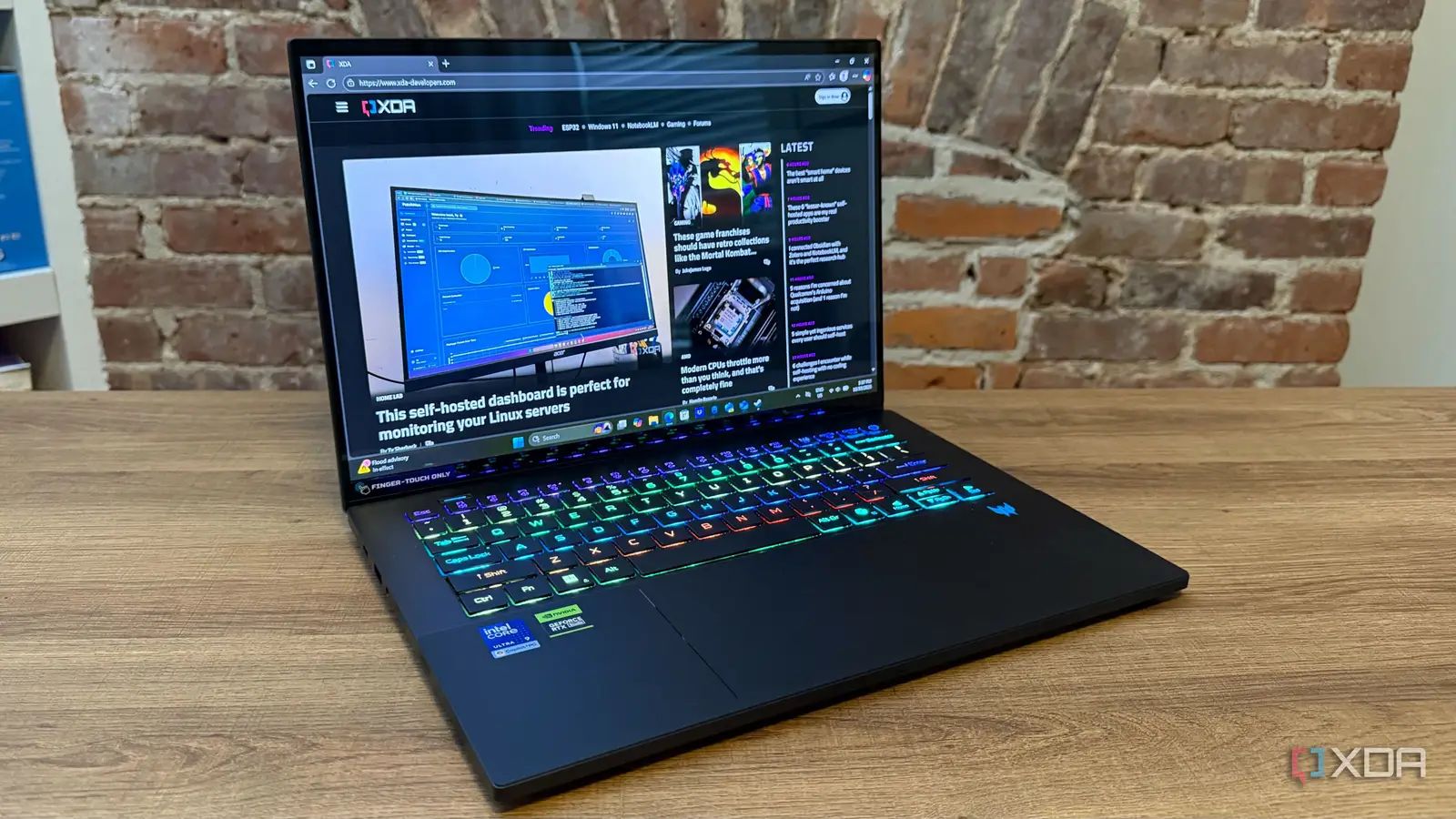Copyright XDA Developers

When I first came across the Acer Predator Triton 14 AI at Computex earlier this year, I was immediately sold by its ultraslim 14-inch chassis, and further intrigued by its unique processor choice. While most gaming and creator laptops have opted to use AMD's Strix Point or Fire Range processors or go with Intel's more powerful Arrow Lake platform, the Triton 14 AI is unique in that it matches Intel's highly efficient Lunar Lake SoC with a discrete GPU. To be honest, I wasn't entirely sure you could connect a discrete GPU to Lunar Lake, but Acer found a way. While the Triton 14 is part of Acer's Predator gaming lineup, it's designed to fit into the overlap between gaming laptops and content creator machines. Not only does the Triton 14 AI meet the Copilot+ standard, it's also a slim, light, 14-inch laptop with an OLED touchscreen and MPP 2.0 stylus. However, it's still got some gaming laptop bells and whistles, including Acer's Predator Sense software, per-key RGB lighting on the keyboard, and RGB Predator logos on the keyboard deck and cover panel. I'm often wary of hybrid devices like the Predator Triton 14 AI, as products that try to be many things at once often fail to excel in any particular area. And yet, I was pleasantly surprised by the Triton 14 AI. It's got solid battery life, decent RTX 5070 performance, a stunning OLED display, and the price tag isn't unusually steep for an RTX 50-series laptop. Acer Predator Triton 14 AI pricing and availability When can you get your hands on one? There are currently only two configurations of the Acer Predator Triton 14 AI available. Our $2,499 review model features an Intel Core Ultra 9 288V processor and Nvidia GeForce RTX 5070 (8GB) GPU, 32GB of system memory, a 1TB SSD, and a 14.5-inch, 2880x1800, 120Hz OLED Touch display. This version of the Triton 14 AI is available through Costco. Micro Center has a slightly more expensive model with a 2TB SSD, which retails for $2,599. Included alongside the Acer Predator Triton 14 AI laptop is a 140W charger and MPP 2.0 stylus for use on the glass touchpad. While $2,499 isn't a cheap price for a 14-inch laptop, it's not unusual given the prices of other RTX 50-series laptops. Other 14-inch, RTX 5070 slim gaming laptops, such as the Razer Blade 14 (2025) and HP Omen Transcend 14 (2025), have been priced around the same $2,000-2,499 threshold. Therefore, the Triton 14's pricing is fairly competitive, all things considered. Designed for creatives, with a gamer twist The Triton 14 AI isn't just a gaming laptop Between its per-key RGB keyboard and light-up Predator logos on the top cover and keyboard deck, the Triton 14 AI is definitely a gaming laptop. And as an RTX 5070 laptop, it's pretty light and thin, weighing just 3.53 pounds. The Triton 14 AI's Charcoal Black aluminum chassis is sleek and understated, as the abstract Predator logo on the front cover is the only real giveaway that it's a gaming laptop. You can also disable the RGB lighting for a more professional appearance. This is handy if you're using the Triton as a school or content creation device rather than a gaming laptop. My only real complaint with the design is the invisible touchpad. It's one of the design choices made famous by the Dell Premium (formerly XPS) lineup that I just can't get behind, and I'm not a fan of it here either. Thankfully, the Triton has lights and haptics at the edges to let you know you've moved your fingers too far off the trackable surface. Although the haptics don't translate well when using the included stylus for controls, as the OLED touchscreen is designed for finger touch gestures only. Since the Triton 14 AI is a clamshell laptop rather than a 2-in-1 convertible, the lack of pen support for the touchscreen is understandable. But it's not just the included stylus and touchscreen that make the Triton 14 AI a crossover gaming/creator laptop. Acer put a Calman-verified, 100% DCI-P3-rated OLED display on the Triton. While the glossy display hits just 350 nits of maximum brightness, it's incredibly vivid thanks to the deep color saturation and near-infinite contrast ratio of the OLED panel. And that makes the Triton fantastic for color grading, but it also makes your games look fantastic as well. Surprisingly good battery life Lunar Lake is still efficient, even with a discrete GPU onboard The Triton 14 AI isn't specifically designed for extended battery life. It does have an RTX 5070 onboard, which means it will get just a few hours of unplugged gaming battery life. Especially if you're playing an online game. Nvidia has updated its Battery Boost technology to eke out a few more minutes of battery life in gameplay, but that technology is better at keeping your games stable when running on battery power rather than massively changing the battery life expectations of a gaming laptop. Rather than turning your games into a slideshow when running off battery power, Nvidia's new Battery Boost tech will switch to optimized settings for smoother performance when operating on battery power. And this does get you some extra game time, but it's not game-changing. However, with the Triton 14 set to either the Balanced or Quiet profiles, you can get a full day of battery life (8-10 hours) with the display set to about 50% brightness. While this wouldn't be fantastic for your standard Lunar Lake laptop, it's amazing battery life for a gaming laptop. Gaming rigs tend to run out of juice after a few hours of web surfing or general productivity usage, even with the discrete GPU turned off. But even with its power-hungry OLED display, I could get through a workday on the Triton without needing to hunt down my charger only a few hours in. You aren't getting all-day battery life, nor are you getting multi-day battery life, but it's still pretty darn fantastic for a gaming rig. A decent bit of credit for that power efficiency is thanks to Intel's Lunar Lake architecture. But it's also courtesy of Nvidia's updated Whisper profile that dials the RTX 5070's power draw to almost nothing when it isn't in use. Lunar Lake and RTX 5070 performance A surprisingly powerful combination In terms of raw power, the Intel Core Ultra 9 288V is the most powerful Lunar Lake chip out there, but AMD's Fire Range is arguably the best mobile CPU for gaming this generation. And that's to be expected. Intel Arrow Lake is built for high-performance mobile workloads and gaming, and AMD Fire Range has AMD's proprietary 3D cache technology for boosted game performance. Most thin and light gaming laptops this generation have opted for AMD Strix Point or Intel's Arrow Lake H platforms since they require less power and less thermal management than Arrow Lake HX or Fire Range. So the Triton 14 AI is certainly unique. Unfortunately, because it's running Lunar Lake, it does fall behind in performance workloads compared to the Razer Blade 16 (2025) or a more traditional powerhouse gaming laptop like the HP Omen Max 16. However, it performed surprisingly well compared to the Razer Blade 14 (2024). The Triton was still the weakest of the bunch, but not by as many points as I initially expected. As for real-world gaming performance, the Triton 14 AI could put up some solid frame rates. In Final Fantasy XIV: Dawntrail I was easily clearing 80 fps with the Triton set to 1800p and High (Laptop) settings. That frame rate dropped a bit when I ventured into busier server areas or newer content zones, but still stayed well above 60 fps. In Baldur's Gate III, the Triton also pulled smooth, stable frame rates on high graphics presets and 1800p resolution. I pushed the Triton a bit further with the gaming benchmarks, just to see where exactly its Core Ultra 9 288V and RTX 5070 combo top out. Obviously, this test suite is pushing both the CPU and GPU to the limit, and you likely wouldn't be gaming at these settings on the Triton 14 AI. It's just an RTX 5070 laptop, after all. And it can game at the full 1880p resolution, but you'll want to dial your graphics presets down to High rather than Ultra High if you plan to game at the max panel resolution. Alternatively, you get far better performance by turning on DLSS and frame generation, if you're willing to accept "fake frames" in your games. Should you buy the Acer Predator Triton 14 AI? Is the Triton 14 your next laptop purchase? You should buy the Acer Predator Triton 14 AI if: You want an ultra-portable gaming laptop You want a laptop for photo or video editing that can also game You want an RTX 50-series laptop with good battery life You should NOT buy the Acer Predator Triton 14 AI if: You need to stay on a tight budget You want desktop-replacement performance The true benefit of the Acer Predator Triton 14 AI is its portability. This is an ultra-thin, ultra-light laptop with a discrete GPU that can game or do photo and video editing with solid battery life. It's a fantastic choice for a STEM student or frequent traveler who wants a gaming laptop. However, it's not a cheap laptop, so if you need to stick to a budget, opting for the RTX 5050 version of the HP Omen Transcend 14 probably makes the most sense. Alternatively, if you don't need a discrete GPU, the Asus Zenbook S 14 with Intel's Lunar Lake has enough integrated graphics power to handle gaming at 1080p and medium graphics presets. But if you don't want to compromise on your GPU power and still get a light, thin 14-inch laptop with a fantastic OLED display, it's hard to deny that the Triton 14 AI is one of the best choices available.



